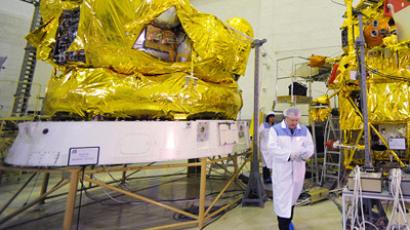Three days to save Martian moon probe
Russia launched an unmanned probe to one of Mars’ moons – Phobos – in the early hours of Wednesday, but it has hit technical trouble. Federal Space Agency officials say they have three days to sort the problem out.
After the probe separated from its booster rocket, its own engine was supposed to generate two impulses in order to direct the spacecraft into an interplanetary trajectory. However, for reasons unknown, this never happened, and the maneuver was not performed. As a consequence, the Phobos-Grunt probe remains in a low transitory orbit.“The engine installation did not function properly: it gave neither the first, nor the second impulse. This means that [the station] did not manage to position itself relative to the stars,” the head of Russia’s Roskosmos space agency, Vladimir Popovkin, told journalists on Wednesday.He added that the spacecraft’s orbit is known and the connection is normal; fuel tanks are in place and there is enough fuel.The head of Roscosmos said that even though the situation is abnormal, this and other similar scenarios are always factored into any plans, and there is a troubleshooting procedure for this particular situation. Should the problem be due to a software failure, the specialists will try to upload a new version to the station, he explained.Meanwhile, RIA Novosti quotes an unnamed scientist who insists that the time scale for the probe's possible controlled exit from the orbit before being directed into its intended trajectory, is somewhere between one week and one month.Phobos-Grunt has comprehensive insurance with the Russian Insurance Center (“Russky Strakhovoy Tsentr”), the company told Interfax news agency. They say the risk hedging was reinsured on the Russian and Western markets. Though the company has not revealed the actual cover, a source in the insurance market says it is 1.2 billion roubles (almost $40 million).
Souvenirs from the Red Planet
The probe is designed to bring back soil from the Martian moon Phobos, which should unearth some secrets about our solar system’s creation. Also on board is China’s first Mars satellite, which is to be put in observation orbit around the Red Planet. Ever since Galileo Galilee first pointed his telescope at Mars, people could not help but wonder – is there life on the Red Planet? The question is still in the air. Russian scientists were set to study Mars and one of its two moons – Phobos – in a single mission. As the focus is obtaining a piece of Phobos’ soil, the whole project and the probe have become known as Phobos-Grunt, meaning “soil” in Russian. Costing around $156 million, it is Russia’s first interplanetary mission since 1996.If all goes to plan, it will take the probe 11 months to reach the Martian orbit and another six to approach Phobos. Immediately after touchdown, a remote-controlled arm is to sink its claw into the unknown.Scientists working on the program say nobody knows how hard the surface is going to be, but they will be able to collect a sample whether it is sand or rock.The return rocket is to make its way back to Earth straight away, hopefully with the first-ever soil samples from a Martian moon on board.
Earthlings' journey to Mars
This mission is one of the most complicated ever planned. The whole structure of Phobos-Grunt weighs over 13,000 kilos, but only seven kilos placed on the top of the return rocket are to make it back to Earth – all this for just 100 grams of precious extraterrestrial soil.However, the rocket will also carry some unusual passengers. Russian and US scientists are sending a capsule with terrestrial micro-organisms on the three-year round trip. With a manned mission to Mars high on the world’s wish-list, but still impossible, the bacteria will act as test subjects. “Thus we’ll be able to see which spores will survive the severe radiation of an interplanetary flight,” says Lev Zelyony, director of the Institute of Space Research. “And as they were put together by different scientists, there’s already a lot of joking about which bacteria will survive – Russian or American?” he adds.However, that was not to be the end of the mission. Part of the spacecraft – the lander – was to remain on Phobos to continue other experiments with a whole array of instruments put together by various countries.Victor Hartov, Phobos probe designer, stresses the importance of the mission:“After all, the main thing really is that we get a better understanding of our Earth and the formation of the Solar System, and maybe it will help us to figure out if Mars can be a reserve planet for the mankind.”And with so many people across the globe eager for this mission to succeed, the hopes are it will turn what has been the impossible into a reality.













